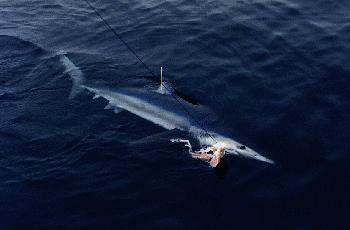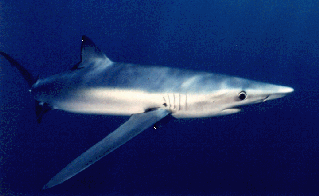Blue Sharks Prionace glauca
RESEARCH
Blue shark tagging efforts...

Photo: Pelagic Shark Research Foundation
DESCRIPTION
The Blue shark represents the archetypal Pelagic shark and is the state of the art pelagic Carcharhinid. It is rivaled only by the mako and oceanic white tip shark as the principle high seas predator. Blue sharks are built like a long range glider with long slender fuselage and long blade like pectorals and high vertical stabilizer that allows for efficient long range cruising with minimum effort. While built to cruise, blue sharks can unload for rapid bursts of speed and hard turns while running down prey or evading interception.
Blue sharks eat mainly fish and squid but have been seen to attack
dead and injured marine mammals of many types.
Two of the largest accurately measured blue sharks were from the S.W
Atlantic and the NW Atlantic, both sharks were nearly 13' ft long; both of
these sharks were out of the water for many hours prior to being weighed
and had lost much weight when tipping the scales at 460 and 600 lbs.
In the pacific ocean lore has blue sharks reaching 15-20' ft in lenght
but the largest accurately measured (that I can find) is about 10' ft long
and 370 lbs from New Zealand. Blue sharks are believed to reach maturity at
about 6' ft for males and 7' for females. It is estimated to take at least
12 years to reach that length.
Blue sharks are viviparous and give birth to live young in litters
ranging from fifty to over a hundred, (although 50 is more common)
gestation lasts 9-12 months.

Photo by: Jim Knowlton
RELATIONSHIP TO MAN
Often seen finning the surface by mariners the blue shark is so named
because of its striking cobalt blue dorsal surface, also known as blue
backs or blue whalers it was a highly un-popular shark among early sailors
and whalers of many nations because of the blue sharks penchant for
arriving at whale kills, mishaps or calamities in great numbers and for
generally compounding the difficulties of life on the open-seas. While not
generally considered a "man-eater" blue sharks are very dangerous when
provoked or mishandled.
During the countless disasters at sea that were experienced by all the
nations involved in the two world wars of the 20th century, blue sharks
were incriminated in the overwhelming majority of shark eats shipwrecked
sailor/downed pilot scenarios.
REPRODUCTION
Gestation is speculated to take 8-10 months.
Blue sharks are born live in litters of varying numbers that can range anywhere from 50-100+.
Blue sharks are long lived and may take a dozen or more years to reach maturity at a length of 6'-8' feet long.
Blue shark pups are approximately 13"-16" in. long and are near perfect replicas of the adult.
The largest blue sharks ever measured where almost 13'-14' ft. long and weighed several hundred pounds.
BEHAVIOR
CONSERVATION
Blue sharks are being heavily impacted by world-wide commercial fishing.
Long-lines and
gill-nets have taken a gigantic toll on blue sharks over the last 20 years
and really big blue sharks are becoming scarce. The finning and shark
cartilage markets are targeting blue sharks which are not considered good
table fair.
The blue shark, Prionace glauca represents the archetypal pelagic shark.
Built for long-range gliding the blue shark is perfectly suited for
crossing vast ocean basins.
Austin/PSRF
| 
Photo by PSRF
|
Blue sharks are very bold and determined foragers with keen eyesight as
well as a well-developed sense of smell.
Fritz-Cope/PSRF
| 
Photo by PSRF
|
Blue shark's snout is packed with sensitive electrical field detection
equipment that enables it to track and zero in on a prey item. Blue
sharks
are known to be able to exert bursts of speed although they are designed
to
cruise over great distances with minimum energy expenditure. Blue sharks
hunt everything from squid to tuna, they are opportunistic foragers that
will not hesitate to consume densely packed krill, scavenge off of a
dead
whale or pursue an injured porpoise. They have been known to consume
dead
and injured sailors and pilots during air/sea war disasters.
Fritz-Cope/PSRF
| 
Photo by PSRF
|
PSRF Director Sean Van Sommeran executes a carefully timed tail grab on
a
small blue shark.
The blue shark was lured close to the boat with a piece of salmon on a
monofiliment.
As the shark comes within reach, it can be carefully grabbed and/or
scoop
netted. The shark can then be brought briefly aboard to be measured,
sampled, tagged and released. Grabbing a blue shark should be done with
extreme caution, they are able to flex and twist all the way around and
bite their own tail or an offending hand.
Atre/PSRF
| 
Photo by PSRF
|
PSRF staff technician Tushar Atre restrains a small blue shark while
demonstrating its indigo blue dorsal surface for which the shark is
named.
The shark is kept out of the water for no longer than 3 minutes as it is
measured, gendered, tagged and released. These sharks are often sampled
for blood and tissues.
Van Sommeran/PSRF
| 
Photo by PSRF
|
PSRF Director Sean Van Sommeran puts a blue shark into tonic immobility
by
rolling it over on its back.
By rolling a small shark over and suspending them in an inverted
position
the shark will sometimes go into what is called tonic immobility where
it
can be more easily measured and sampled. This state of immobilization
should never be taken for granted and does not always last very long.
Atre/PSRF
| 
Photo by PSRF
|
PSRF staff photographer Callaghan Fritz-Cope releases a small blue shark
after it has been tagged and sampled. With sharks less than 5 feet long
a
scoop net or a carefully timed tail grab is used to collect and
temporarily
restrain them for sampling. This method is much less likely to injure
the
shark than hook and line capture.
Van Sommeran/PSRF
| 
Photo by PSRF
|
|
